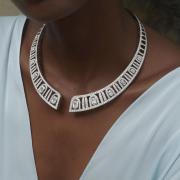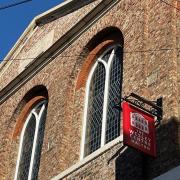Here’s a woman with a gem of a job. As a fossil-obsessed seven-year-old Sarah Steele was fascinated by Whitby jet. Today she’s a world expert – possibly the world expert – on the black stuff. We 60 met her in the workshop and by the shore.
In a town that doesn’t bat an eyelid at the sight of a bit of costume drama, Sarah Steele cuts a bit of a dash.
Striding through the narrow streets of Whitby in a floor-length stockman’s coast, a mane of tawny curls flying behind her, she’s heading to the beach in pursuit of just one thing – jet, the glossy black gemstone for which the town is rightly famous.

These days, she runs her own shop on picturesque Church Street. It’s a ship’s cabin of a place where she and husband David and son Archie make their own spectacular jet jewellery to sell alongside a small selection of gorgeous vintage.
Sarah is also a highly qualified academic: her first degree was in geology. She’s a professional gemmologist, awarded a Diamond Fellowship of the Gemmological Association of Great Britain a decade ago, and a member of the Gemmological Associations of Canada and Scotland. She’s the consultant gemmologist at Whitby Museum, and currently studying for her PhD at Durham University – her specialism is a new methodology for the identification of jet.

There’s no simple answer. 'I don’t know!' says Sarah. 'It was just the best thing I’d ever seen. There’s something about jet that is inherently magical. It’s a talismanic material. I think that explains why the British have used it for five-and-a-half thousand years. It still looks like a living wood, it burns like a wood, you could turn it like a piece of wood, and yet you find it deep in a cliff – I think that would challenge people, certainly pre the invention of geology and the understanding that the world was as old as it is.'
Fascinating facts about jet spill out of Sarah like fossils from a crumbling cliff face. Did you know, for instance, that jet played a role in the invention of plastic?

It’s well known that the demand for jet boomed after Queen Victoria’s beloved consort, Prince Albert, died in 1861 and she popularised the gem as a symbol of mourning. But the fashion actually started 30 years earlier.
'When George IV died in 1830, the Lord Chamberlain’s Office decreed that the Empire was in mourning and should wear black crepes and jet ornaments. Whitby went from two jet shops to over 200 factories almost overnight. We cannot comprehend the demand today: every single building would have been a jet workshop; the air was full of jet dust. There were buildings hanging on the cliffside on stilts – it must have looked like a shanty town.

The eventual collapse came about, Sarah says, for a variety of reasons: the advent of plastics; jet was mined out; poor quality foreign imports undermined the domestic industry.
'When they realised what was happening, they tried to formulate a hallmarking scheme, but it was too late to save the industry. By 1900, they were just selling leftover stuff.'
The history of jet in Whitby goes back way, way before the Georgians and Victorians, though.

Jet these days is mostly found on the beaches or at sea – but that wasn’t always the case.
'There are at least 300 documented mines across the North York Moors National Park, mostly clustered around Bilsdale and Roseberry Topping, but there are many, many more than that. Some are just shallow pits, but in 2016, a mine was found that’s over four miles long, and since then we’ve found another of similar length. So we now know that what we once thought was a cottage industry was much bigger.

'Who were they? Almost certainly the Romans were good candidates, but look at the volume of Bronze Age jet we see: you can’t just pick that up on the beach. These mines are almost certainly from pre-history.'
Sarah is keen to stress that anyone finding what they believe to be a jet mine should never risk going into it. 'I'm lucky enough to have been down a few of them with the North York Moors Caving Club – you’re crawling commando-style for hundreds of metres.'



























